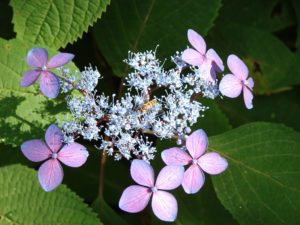Gardeners play a critical role in the nurturing and conservation of both native and introduced pollinators. Gardens and landscapes provide pollinators with food, water, shelter and habitat to complete their life cycles. Urban areas typically feature large areas of pavement and buildings and offer little in the way of food or shelter for pollinators. Garden plantings can help bridge the gap.
By federal proclamation, June 17-23, 2019, is National Pollinator Week. Now in its 12th year, the focus of this designation by the U.S. Departments of Agriculture and the Interior is to promote the health of pollinators, so critical to food and ecosystems.
It may surprise you to learn that the honeybee is native to Europe and was introduced to the U.S. But there are numerous other pollinator species, including native bees, butterflies and moths, beetles, birds and bats. Many pollinators have suffered from loss of habitat, chemical misuse, diseases and parasites.
Honeybees and other pollinators need protein from flower pollen and carbohydrates from flower nectar. Plan to provide a variety of different types of flowers, and aim to have three different flower species in bloom throughout the growing season. Showy, colorful flowers and massed groups of flowers, particularly in small gardens, provide efficient feeding stations for the pollinators. Flowering trees and shrubs also provide excellent food sources.
Pollinators also need shelter from wind, scorching sun and heavy rains. Plants, garden structures such as fences, and windbreaks may make the garden more attractive to pollinators.
Pesticides can harm bees and other pollinators directly or may change their behavior or reproductive potential. Some chemicals make pollinators more susceptible to disease.
You can protect pollinators by using alternative prevention and control strategies, such as hand-picking pests, mulching and by being selective when it becomes necessary to use pesticides.
Read and follow all label directions, and pay particular attention to timing your application to minimize impact on pollinators. Generally, bees and others are less active in very early morning or at dusk. Choose spray rather than dust formulations of pesticides to lessen potential for contact. Avoid using pesticides in areas where pollinators are likely to forage. Maintain a buffer “no-spray area” when possible. Wait until flowers have faded (petal-fall) before applying. Mow the lawn to remove flowers of weeds before spraying.
Want to learn more? Purdue Extension has a series of publications on Pollinator Protection that are free to download.
Protecting Pollinators in Home Lawns and Landscapes is targeted to homeowners.
https://edustore.purdue.edu/item.asp?Item_Number=POL-1
Recommended Indiana-native Plants for Protecting Pollinators
https://edustore.purdue.edu/item.asp?Item_Number=POL-6-W
Best Management Practices for Indiana Pollinator Habitat
https://edustore.purdue.edu/item.asp?Item_Number=POL-5
Protecting Pollinators in Fruit and Vegetable Production is aimed at commercial vegetable growers, but the information is applicable to home gardeners as well.
https://edustore.purdue.edu/item.asp?Item_Number=POL-2
Why Should We Care About Pollinators?
https://edustore.purdue.edu/item.asp?Item_Number=POL-7
Additional information on National Pollinator Week
https://www.pollinator.org/

